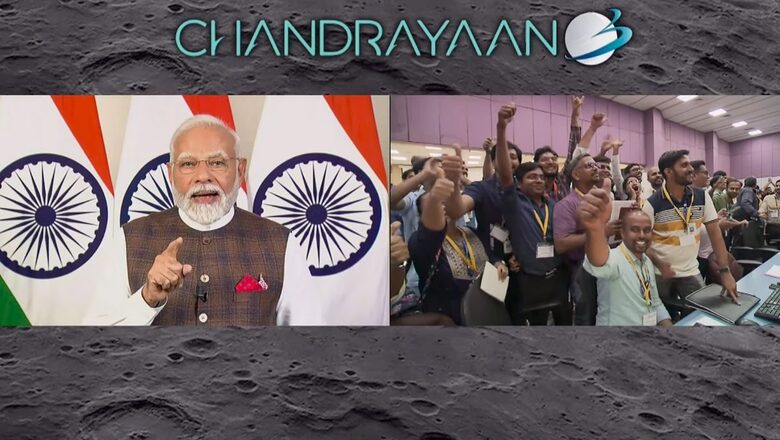
views
“We are witness to the new flight of New India. A new history has been written” — Prime Minister Narendra Modi, on the iconic Moon landing by India, on August 23, 2023.
Soon after the announcement of Vikram lander’s touchdown near the Moon’s south pole, PM Modi addressed the Indian Space Research Organisation (ISRO) scientists, celebrating the stellar achievement. Modi called the moment unprecedented and unforgettable and said that the ISRO mission had a human-centric approach and thus, Chandrayaan-3’s success was an achievement for all of mankind, displaying true statesmanship.
“If everything fails, if all the sensors fail, nothing works, still it (Vikram) will make a landing. That’s how it has been designed, provided that the propulsion system works well,” ISRO director S Somnath had said, prior to the iconic Moon landing. It shows the painstaking efforts and detailing undertaken by ISRO to ensure the success of Chandrayaan-3. With the soft landing on the lunar south pole, as in the dark side of the Moon, India has become only the fourth country in the world after the United States, the Soviet Union and China to have achieved this magnificent feat. India’s space economy is expected to be worth over $13 billion by 2025.
In the last nine years, under Prime Minister Modi, India has witnessed a quantum jump in its space journey and now stands at par with countries like the US. Out of 424 foreign satellites launched to date by India, 389 were launched in the last nine years of the government headed by PM Modi. Further, out of $174 million earned, $157 million came in the last nine years and similarly, out of €256 million earned so far, €223 million came during the nine years of the Modi regime.
India’s space sector is fast gaining a pre-eminent position in the world and the countries which started their space programmes long before us, today, increasingly seek our services and our facility to launch their satellites. The Chandrayaan-2 mission cost India Rs 978 crore. But the Chandrayaan-3 project cost India only Rs 615 crore. ISRO is also launching India’s first solar mission, Aditya-L1, at a cost of merely Rs 378 crore, to study the photosphere, chromosphere, and the outermost layers of the Sun (the corona), very soon. The most ambitious one, the Gaganyaan programme at a cost of Rs 9023 crore, envisages undertaking the demonstration of human space flight to low earth orbit (LEO) in the short-term and will lay the foundation for a sustained Indian human space exploration programme in the long run. Basically, Gaganyaan aims to send two unmanned and one three-member manned spacecraft into space. Once successful, India will be the fourth country to have sent a human to space, the other three being the US, Russia and China.
Apart from the core functioning of rocket launching, India’s space applications have become a big source of livelihood opportunities through 130-odd startups after the opening up of the space sector by PM Modi in June 2020. Moreover, in the academic field, technical institutes in Trivandrum, Jammu and Agartala have 100 per cent placements for students and about 50 per cent of them go to the National Aeronautics and Space Administration (NASA) to pursue higher studies.
In 2017, ISRO launched a record 104 satellites aboard PSLV-C37 from Satish Dhawan Space Centre, Sriharikota, of which 101 belonged to international customers, signifying India’s increasing presence in the global space industry. Talking more about India’s startup revolution, before 2014, there were just around 350 startups, but after PM Modi gave the clarion call and rolled out the special Startup India scheme in 2016, there has been a quantum jump in startups to more than one lakh, with more than 100 unicorns. He gave a special boost to the space sector and opened it for public-private participation with an increasing number of startups. Today, the situation is such that the earliest and premier space organisations like America’s NASA are collaborating with ISRO and even seeking expert inputs from us. Before 2014, ISRO used to undertake launches now and then, but after Prime Minister Modi opened the doors of the space sector to private sector participation, today, ISRO is working with nearly 150 private startups.
India also has the world’s third-largest startup ecosystem and has leapfrogged from 81st to 40th in the Global Innovation Index 2022. Similarly, before 2014, India’s bio-economy was valued at $10 billion. Now, it’s over $80 billion. Biotech startups have grown 100 times in the last eight years, from 52 odd startups in 2014 to over 5300 in 2022. Talking about agri-tech startups, before 2014, no one knew about the Aroma Mission or the Purple Revolution. But today, lavender cultivation has led to a boom in agri-tech startups. Similarly, before 2014, there was no concept of preventive healthcare in India, but today, the same India is being recognised as the vaccine hub of the world. Before 2014, the mandate of the Ministry of Earth Sciences was not clearly defined. But through the Samudrayaan project under the Deep Ocean Mission, India is ready to explore the vast resources of the Indian Ocean.
In the 94th episode of his Mann Ki Baat, Prime Minister Modi said, “Our country is doing wonders in the solar sector as well as the space sector. India has placed 36 satellites in space simultaneously just a day before Diwali. With this launching, from Kashmir to Kanyakumari and from Kutch to Kohima, in the whole country, digital connectivity will be further strengthened.” With the help of the satellite launch, the PM further said that the remotest areas will be more easily connected with the rest of the country. Modi added, “I also remember those old days when India was denied cryogenic rocket technology. But the scientists of India not only developed indigenous technology but today with its help, dozens of satellites are being sent to space simultaneously. With this launch, India has emerged as a strong player in the global commercial market. With this, new doors of opportunities have also opened up for India.”
Earlier in India, the space sector was confined within the purview of government systems. But since 2020, revolutionary changes have started coming into it. Indian industries are engaged in bringing innovations and new technologies in this field. The collaboration of IN-Space is going to make a big difference in this area. Non-government companies are also getting the facility to launch their payloads and satellites through IN-Space. Today, India is combining its traditional experiences with modern science and that is why we have become one of the largest countries to generate electricity from solar energy.
“Exploration is in our nature. We began as wanderers and we are wanderers still,” Carl Sagan, an American astrophysicist, famously said once. We, humans, have explored deep and wide, from the depths of the oceans to the highest peaks. Space, the final frontier, has captivated our imagination since time immemorial. The call of the cosmos, the curiosity to know more about our origin, and what secrets lie hidden in the vastness of the universe is the driving force for space explorations. Venturing into space is costly, technologically difficult, and dangerous. But again, success brings us joy, something which lifts our spirits. The world witnessed magic, in July 1969, the historic moment when humans landing on the Moon not only upped the morale of Americans but also served as a reminder of our innate desire to explore and push the boundaries of knowledge. In the same pursuit of this cosmic quest, India launched its ambitious Moon missions, demonstrating frugal cost and indigenous technology.
India’s Chandrayaan-2 mission encountered a setback in 2019 when the lander Vikram failed to achieve a soft landing on the Moon’s surface. However, from this failure, India learned valuable lessons that paved the way for future lunar explorations. PM Modi did not flinch even for a moment and like a true leader, he stood in solidarity with India’s scientific community. The Chandrayaan-2 mission served as a catalyst for innovation, prompting the scientific community to analyse and rectify the challenges faced. This setback ignited a spirit of resilience and determination, driving the development of innovative solutions and improved mission preparedness. In fact, it is the orbiter of Chandrayaan-2 that has been providing key inputs in real-time, to help its successor Chandrayaan-3 which eventually made a flawless landing on the Moon on August 23, 2023.
Critics of India’s spend on space missions often question the allocation of resources in a country with pressing socio-economic challenges. However, it is important to note that India is one of the world’s top economies and its investments in space technology have yielded significant benefits. Spinoff technologies and direct advantages of Indian space forays are helping in sectors such as agriculture, railways, smart cities, water mapping, robotic surgery, defence and more.
PM Narendra Modi has played a pivotal role as a visionary leader with a bold statement of purpose; someone who never gives in or gives up on his countrymen and women. Under his leadership, India’s space programme has flourished, with a keen focus on innovation, efficiency, and self-reliance, making Aatmanirbhar Bharat a pleasant reality. PM Modi’s unwavering support for ISRO and his endorsement of cost-effective space missions aligns with the nation’s ethos of frugality, allowing India to achieve remarkable feats without burdening its economy. Moreover, PM Modi’s emphasis on the practical applications of space technology in agriculture, disaster management, and national security underscores his commitment to harnessing space capabilities for the betterment of Indian society, in particular, and the world at large.
Space is an unforgiving and challenging environment that demands innovation and resilience. Intense radiation, microgravity, and extreme temperatures necessitate technological advancements and rigorous preparation to ensure the success of missions. Then there is space debris. Travelling at more than 24,000 kph, micrometre-sized particles can knock out an entire satellite. India’s foray into space is hence, not only about reaching the Moon but also about gaining valuable knowledge and expertise to pioneer future missions.
While the world fixates on the landing on the south pole of the Moon, India’s Chandrayaan orbiter has a broader scope. Apart from mapping the lunar surface, it aims to conduct experiments related to the Moon’s atmosphere, electromagnetic radiation and even the search for exoplanets. This multifaceted approach expands our understanding of space and contributes to scientific advancements that reach far beyond our immediate lunar neighbour.
India’s space missions symbolise our determination to push boundaries and be at the forefront of space exploration. ISRO operates on a shoestring budget; the Mars orbiter, Mangalyaan, had a price tag of just $75 million, less than the cost of an average Hollywood blockbuster like say, Interstellar, which had a far higher budget of $165 million. Combined with indigenous technology, the multifaceted objectives of these missions showcase India’s expertise and commitment to scientific advancement, aided and abetted by the leadership of PM Modi. As India continues its journey into the unknown, exploring the Moon and beyond, it inspires and instills hope for a brighter future.
A few months back, American astrophysicist and science communicator Neil deGrasse Tyson called Prime Minister Narendra Modi “scientifically thoughtful” and said that India has a “very bright future”. Tyson also said that the potential for what India can establish knows no limits because it has a leader like PM Modi who is not bound by any limits and is always willing to explore the uncharted. Well, India’s tryst with the dark side of the Moon showcases how a leap of faith is sometimes all that it takes to leapfrog a million years ahead of both time and distance.
Sanju Verma is an Economist, National Spokesperson of the BJP and the Bestselling Author of ‘The Modi Gambit’. Views expressed in the above piece are personal and solely that of the author. They do not necessarily reflect News18’s views.


















Comments
0 comment